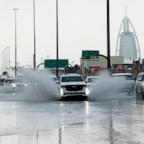BP Oil Spill: The Cut, Clean-Up and Criminal Investigation
Despite BP's claims, underwater plumes exposed.
June 2, 2010— -- An estimated 800,000 gallons of oil a day are now spewing into the Gulf of Mexico, 20 percent faster than before, since the underwater robots began cutting a major pipe. But it could be several more days before BP is able to cap the leak with a containment dome and channel the oil to the surface.
While Admiral Thad Allen said Tuesday he had a "pretty good level of confidence" that the so-called cut and cap technique would work, today they ran into a setback. A saw became stuck during the second cut in an attempt to contain the oil. They are now making a second attempt to cut and should know the outcome later today or early tomorrow, Allen said.
But as BP attempts its seventh try to stop the leaking oil, outrage is mounting in the Gulf Coast and much of it is aimed at BP CEO Tony Hayward.
Louisiana Democrat Rep. Charlie Melancon told "GMA's" George Stephanopoulos that he wants the board of BP to call back Hayward "and give us somebody that really wants to make sure the people of this state, the people of this Gulf Coast region, have what they need, when they want and try and fight this oil [leak]."
"If I performed that, the way this company has performed and of course look at the stocks and what has happened to it because of this incident, usually the buck stops there," Melancon said on "GMA."
But 40 miles out into the Gulf of Mexico, ground zero of the oil leak, scientists have discovered three huge swaths of oil particles, some up to 20 miles long and six miles wide, despite BP's claims that plumes do not exist.
These marine scientists onboard the F.G. Walton Smith, a federally funded research vessel, had read a study released in 2001 by the Minerals Management Service and oil companies -- including BP -- that showed they knew how oil and gas would combine at certain depth and stay in the water instead of rising to the surface.
CLICK HERE to read the study.
On Sunday BP's CEO Tony Hayward denied the existence of plumes below the surface.
"The oil is on the surface. It's very difficult for oil to stay in a column," he said. "It wants to go to the surface because of the difference in specific gravity."
The surface of the water may look clean, but once the scientists deploy sensitive instruments 4,900 feet into the Gulf, they are able to detect any subtle changes in the water's chemistry due to the oil. They have discovered oil and gas plumes suspended there and stretching for miles.




